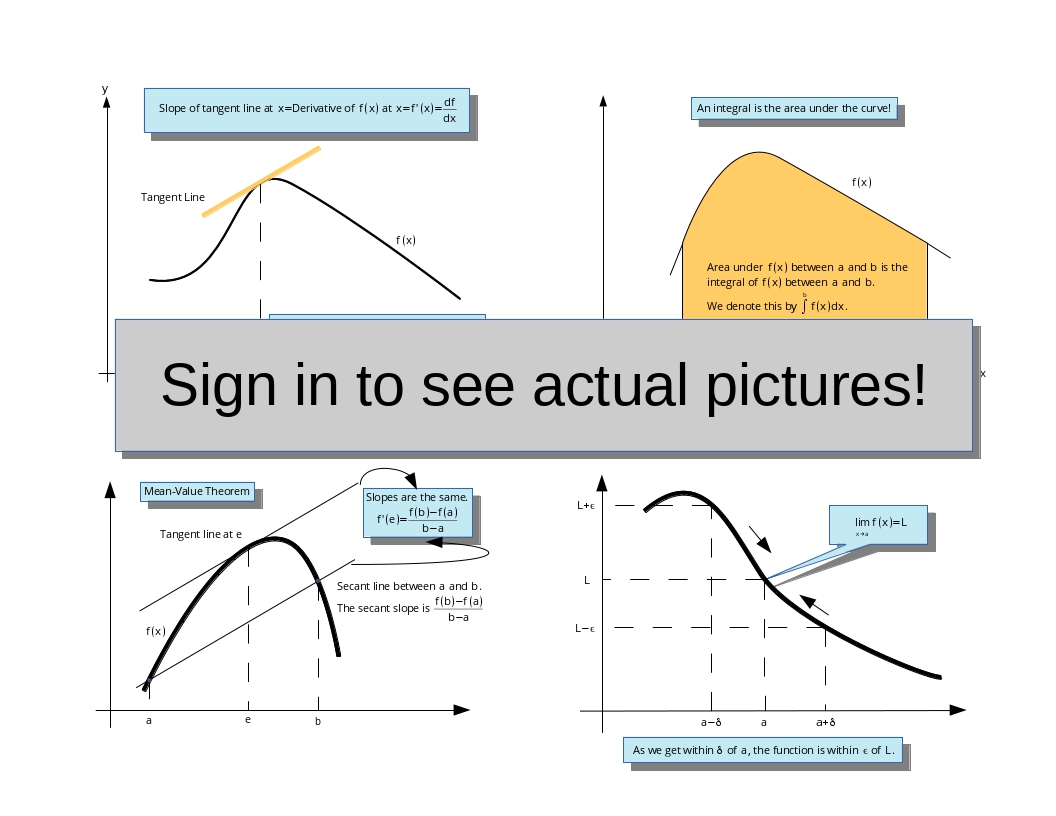Geometry of Functions II: The Extreme-Value Theorem
Primary tabs
SAMPLE LESSON
Sign in for easy to read lessons narrowly focused on a specific subject. All lessons are linked to each other allowing you to easily see the connections between different Calculus concepts. Our unique Calcmap will give you a bird's-eye view of all our lessons and help you see how important concepts are related to each other. All of the formulas are available to our subscribers, but here is a sample of the lesson you will see when you log in:
To gain insight into the Extreme-Value Theorem we will compare two very similar functions. The first is <Sign in to see all the formulas> with the domain <Sign in to see all the formulas>. The second is <Sign in to see all the formulas> with the domain <Sign in to see all the formulas>. The only (obvious) difference between these two functions is that their domains are different. For f(x) the points −1 and 1 are included in the domain while for g(x) they are not. Furthermore, both are continuous functions in their respective domains.
However, there is one extremely important difference. For f(x), it will take on a maximum and minimum value within its domain. The picture below demonstrates that it will take on a maximum value U=3 at x=1 and it will take on a minimum value L=1 at x=−1.

But what about the function g(x)? Because it never actually reaches x=1 it will never take on a maximum value in <Sign in to see all the formulas>. What do the words 'it will never take on a maximum value in <Sign in to see all the formulas>' actually mean? Given any value <Sign in to see all the formulas>, there is always another <Sign in to see all the formulas> such that <Sign in to see all the formulas>. Now we can keep going and know that there is an x3 such that <Sign in to see all the formulas>. And then there is an x4 such that <Sign in to see all the formulas>. And then there is an x5 such that . . . There is never a maximum value in <Sign in to see all the formulas> because there is always some other value in <Sign in to see all the formulas> such that g(x) is greater than all the other values we have found. For the exact same reason, g(x) will never take on a minimum value in <Sign in to see all the formulas>.
It is important to note that g(x) is bounded above by 3 just like it is for f(x). However, this only tells us that <Sign in to see all the formulas>. There is no value of <Sign in to see all the formulas> where <Sign in to see all the formulas>. But for f(x) there is: <Sign in to see all the formulas>.
Another way of saying all of this is that g(x) never gets to a maximum value of 3 because 1 is not in its domain like it is for f(x). Similarly, g(x) never gets to a minimum value of 1 because −1 is not in its domain.

Finally, even the function
<Sign in to see all the formulas>
suffers the same thing as g(x). However, this time it is defined on <Sign in to see all the formulas> like f(x) is, but it is discontinuous at the endpoints.

All of this suggests that a function will take on a maximum and minimum value on its domain if its domain is a closed interval and if it is continuous on that closed interval. This is the Extreme-Value Theorem.
| The Extreme-Value Theorem |
|---|
| If f(x) is continuous on [a,b], then f(x) takes on both maximum and minimum values on [a,b]. |
In the figure below the function takes on a minimum value at x1 and a maximum value at x2. Both x1 and x2 are within the domain [a,b].

Finally, you can find the full proof of the Extreme-Value Theorem here. There is one important point to make about the proof. The proof actually shows that the maximum value will be the function's least upper bound and the minimum value will be its greatest lower bound. If you are not a math major then don't worry too much about this. It is important for some Calculus proofs that math majors will need.
